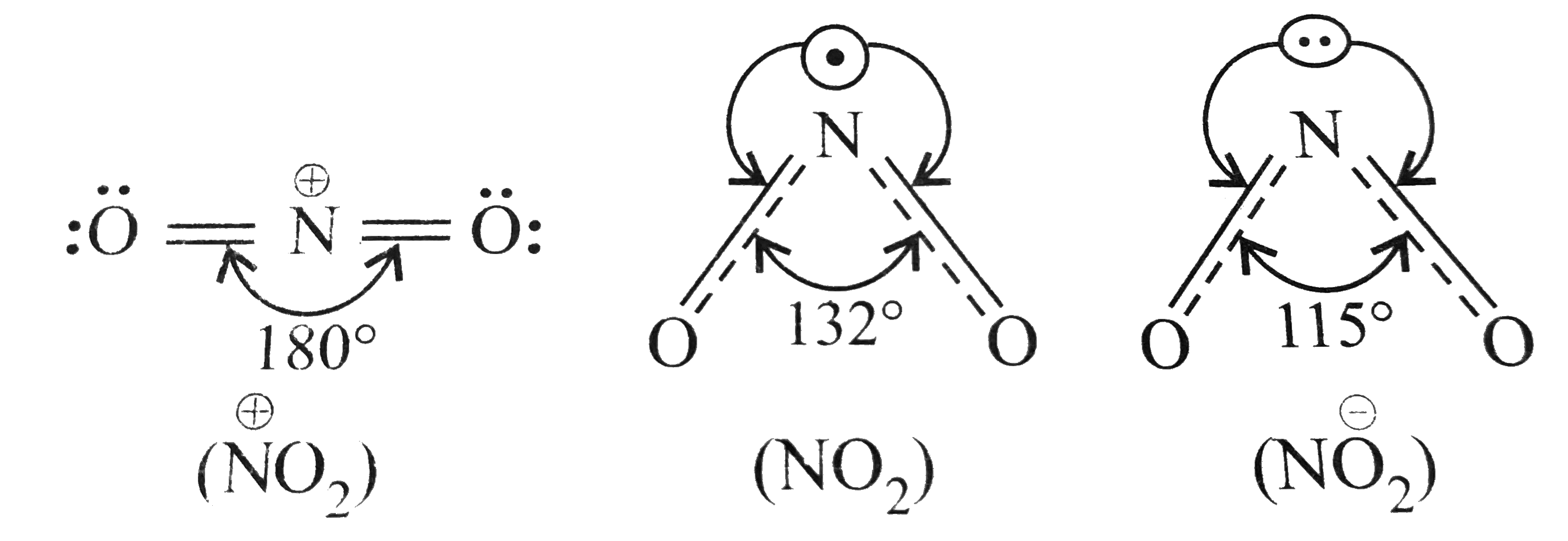Give the decreasing order of the property mentioned against each of the following
C2H2,BF3,H2O,NH3,CH4 (bond angle)
(b) NH3,ΘNH2,⊕NH4 (bond angle)
( c) K−F,Li−CI,Na−I,Br−H,F−H,C−H (ionic character)
(d) NH3,PH3 (bond angle)
(e) NF3,NH3 (dipole mement)
(f) CH3CI,CH2CI2,CHCI3,CCI4 (dipole moment)
(g) MgO,CaO (hardness)
(h) HCI,HBr (ionic characacter)
(i) NO2,NO⊕2NOΘ2 (bond angle)
(j) CI2,O2,F2,N2 (bond strenght)
(k) O,N,F,CI,S (strength of H - bonging)
(I) N2,N⊕2,NΘ2,N2−2 (order of stability)
(m) O2+2,O2,O⊕2,OΘ2O2−2 (order of stability)
(n) N2,F2,O2,H2 (bond lenght) .
Video Solution
Text Solution
CH≡CH(180∘)>BF3(120∘)>CH4(109.5∘)[sp,linear][sp2,planar][sp3,TH]
..NH3(107∘)>H2..O:(104.5∘)>
⎡⎢⎣sp3,pyramidalRepusion betweenlp and bp⎤⎥⎦⎡⎢⎣sp3,V-shapeRepusion betweenlp and bp⎤⎥⎦
(b) ⊕NH4(109∘)>NH3(107∘)>:NH2(104∘)
[sp3,TH]⎡⎢⎣sp3,pyramidalRepusion betweenlp and bp⎤⎥⎦⎡⎢⎣sp3,V-shapeRepusion betweenlp and bp⎤⎥⎦
This is because all of them involve sp3 hybridisation The number of lp s of electrons on N-atom are 0.1 and 2 respectively Greater the number of lp s greater is the repulsions on the s and hence smaller is the angle
(c ) K−F>Na−I>Li−CI>F−H>Br−H>C−H
(Apply Fajans rule)
Refer to Section 1.17 (3) Point (v) NH3>PH3
(e) Refer to IIIuration 2.18 (a)
NH3>NF3
(f) Refer to IIIusation 2.19
CH3CI>CH2CI2>CHCI3>CCI4
(g) MgO>CaO (Hardness decreases down the 2nd group (⏐↓) due to decreases in lattice energy)
(h) HCI>HBr (Apply Fajans rule )
(i) Refer to section 1.17 (3) Point (v)
⊕NO2>NO2>N⊕O2.
⊕NO2 has no unshared electron and hence it is linear NO2 has no unshared electron while NOΘ2 has one unshared electron pair (i.e lone pairs of electrons)
(j) N≡N>O=O>CI−CI>F−F
Triple bond strenght gt doubel bond strenght gt single bond strenght
Bond stregth F−F is less than that of CI−CI due to repuslsion between the non-bonding e− s present on each very small F-atoms
(k) F>O>N>S>CI
Greater the EN and small size of the element it forms stroger H-bonding
(i) Refer to Table 2.19
Na2>N⊕2>NΘ2>n2−2
(m) Refer to Table 2.20
O2+2>O⊕2>O2>O⊕2>O2−2
(n) F2(F−F)>O2(O=O)>N2(N≡N)>H2(H−H)
[Bondxlenght (pm)]144>121>109>74
Bond lenght of single bond gt double bond gt triple bond
Since the H-atom is very small size so bond lenght of single bond between H and H is the smallest .
 .
.
|
Topper's Solved these Questions
- CHEMICAL BONDING AND MOLECULAR STRUCTUREBOOK - CENGAGE CHEMISTRYCHAPTER - CHEMICAL BONDING AND MOLECULAR STRUCTUREEXERCISE - Ex 2 .2 Subjective (Intermolecular Forces And H-Bonding)
7 Videos
- CHEMICAL BONDING AND MOLECULAR STRUCTUREBOOK - CENGAGE CHEMISTRYCHAPTER - CHEMICAL BONDING AND MOLECULAR STRUCTUREEXERCISE - Ex 2 .2 Subjective (Molecular Orbital Theory)
4 Videos
- CHEMICAL BONDING AND MOLECULAR STRUCTUREBOOK - CENGAGE CHEMISTRYCHAPTER - CHEMICAL BONDING AND MOLECULAR STRUCTUREEXERCISE - Archives Subjective
15 Videos
- ATOMIC STRUCTUREBOOK - CENGAGE CHEMISTRYCHAPTER - ATOMIC STRUCTUREEXERCISE - Concept Applicationexercise(4.3)
19 Videos
- CHEMICAL EQUILIBRIUMBOOK - CENGAGE CHEMISTRYCHAPTER - CHEMICAL EQUILIBRIUMEXERCISE - Archives (Subjective)
11 Videos
Similar Questions
Knowledge Check
IUPAC name of C2H5−CH3∣CH−NH2 is
Aethyl methyl amineBbutane amineCmethyl ethyl amineD2- butanamineThe correct order of basicities of the following compounds is -
(I)_E01_945_Q01.png) , (II) CH3CH2NH2 : (III) (CH3)2NH , (IV) CH3−O∣∣C−NH2⎞⎟
⎟⎠AII>I>III>IVBI>III>II>IVCIII>I>II>IVDI>II>III>IV
, (II) CH3CH2NH2 : (III) (CH3)2NH , (IV) CH3−O∣∣C−NH2⎞⎟
⎟⎠AII>I>III>IVBI>III>II>IVCIII>I>II>IVDI>II>III>IVThe decreasing order of the basic character of NH3,CH3NH2,C2H5NH2 and C6H5NH2 is
ANH3>CH3NH2>C2H5NH2>C6H5NH2BC2H5NH2>CH3NH2>NH3>C6H5NH2CC6H5NH2>C2H5NH2>CH3NH2>NH3DCH3NH2>C2H5NH2>C6H5NH2>NH3
Arrange the following in order of decreasing bond angles
(i)CH4,NH3,H2O,BF3,C2H2 (ii)NH3,NH−2,NH+4
View SolutionThe correct order of bond angles among the compounds CH4, NH3 and H2O is
(A) H2O < NH3 < CH4
(B) NH3 < H2O < CH4
(C) NH3 < CH4 < H2O
(D) CH4 < H2O < NH3
View SolutionArrange the following in order of decreasing bond angles
(i)CH4,NH3,H2O,BF3,C2H2 (ii)NH3,NH−2,NH+4
View SolutionOn the basis of VSEPR theory, predict the shapes of the following molecules/ions?
a. AsF5 , b. SbCl3 , c. F2O , d.H3O⊕
e. HC≡CH , f. ⊕NH4 , g. o−NH2 , h. GeF4
View SolutionWhich of the following has larger bond angle in each pair ?
(i)CO2,BF3(ii)NH3,CH4(iii)H2O,H2S(iv)SF4,C2H2.
View Solution